Homemade Mandu (Korean Dumplings)
Mandu are delicious Korean dumplings filled with pork, cabbage, chives and Korean glass noodles. This homemade mandu recipe will help you make juicy dumplings from scratch with these step-by-step instructions.
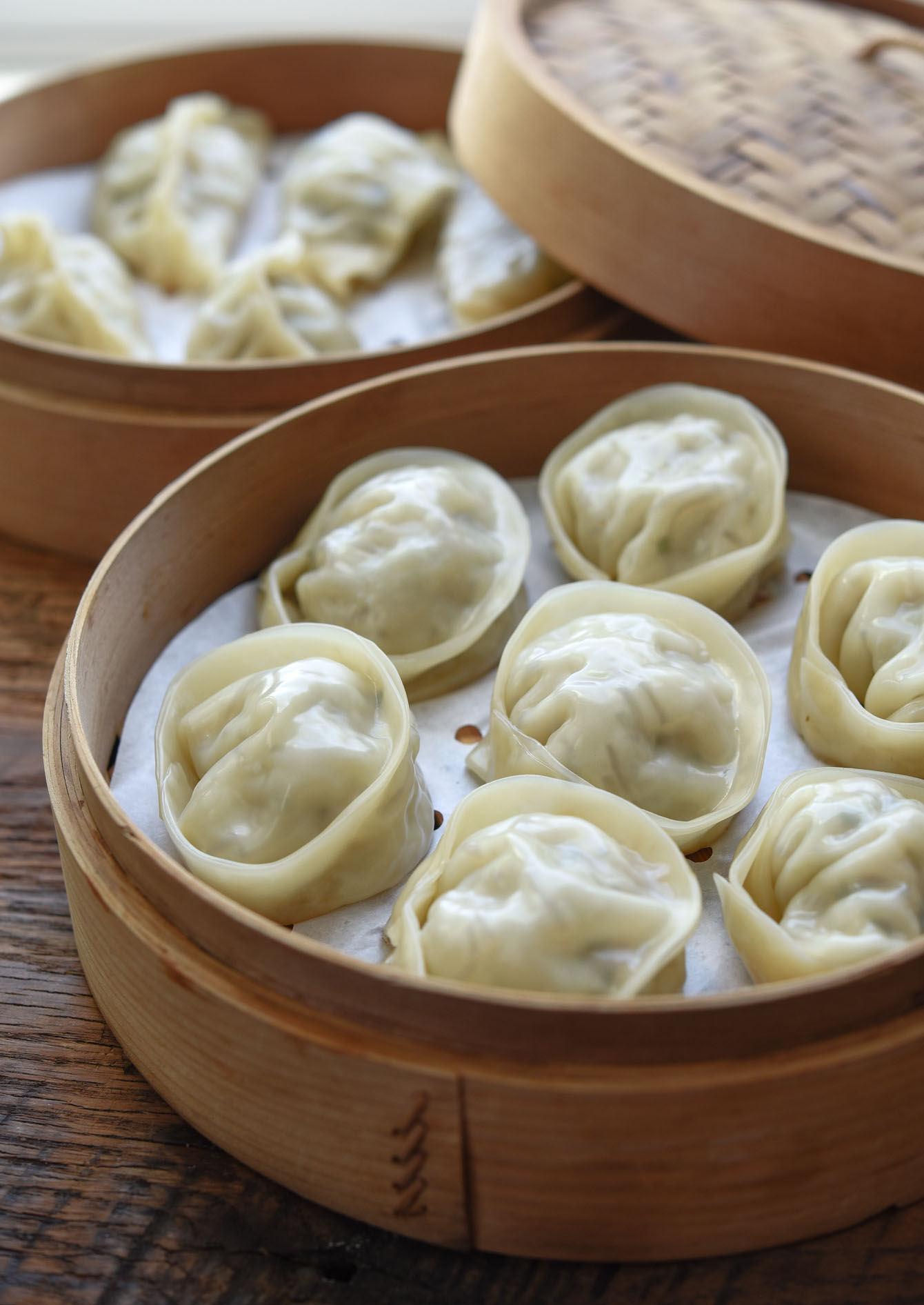
“I just made these today and my family LOVES them. I had to use dried chives instead of fresh Asian chives, and grape juice instead of sweet rice wine but it still tasted amazing to us. My great-aunt said that they tasted as good as restaurant dumplings. Thank you so much!”
Emma
In Korea, homemade mandu is a must-have for the Lunar New Year. These dumplings, filled with tasty meat and veggies, offer a bite full of satisfaction. But don’t just save mandu for the New Year—they’re perfect for any day.
Making mandu is a fun activity to do with your loved ones, turning an ordinary day into something special. So, gather your family and friends, and enjoy the simple pleasure of making and eating mandu whenever you fancy.
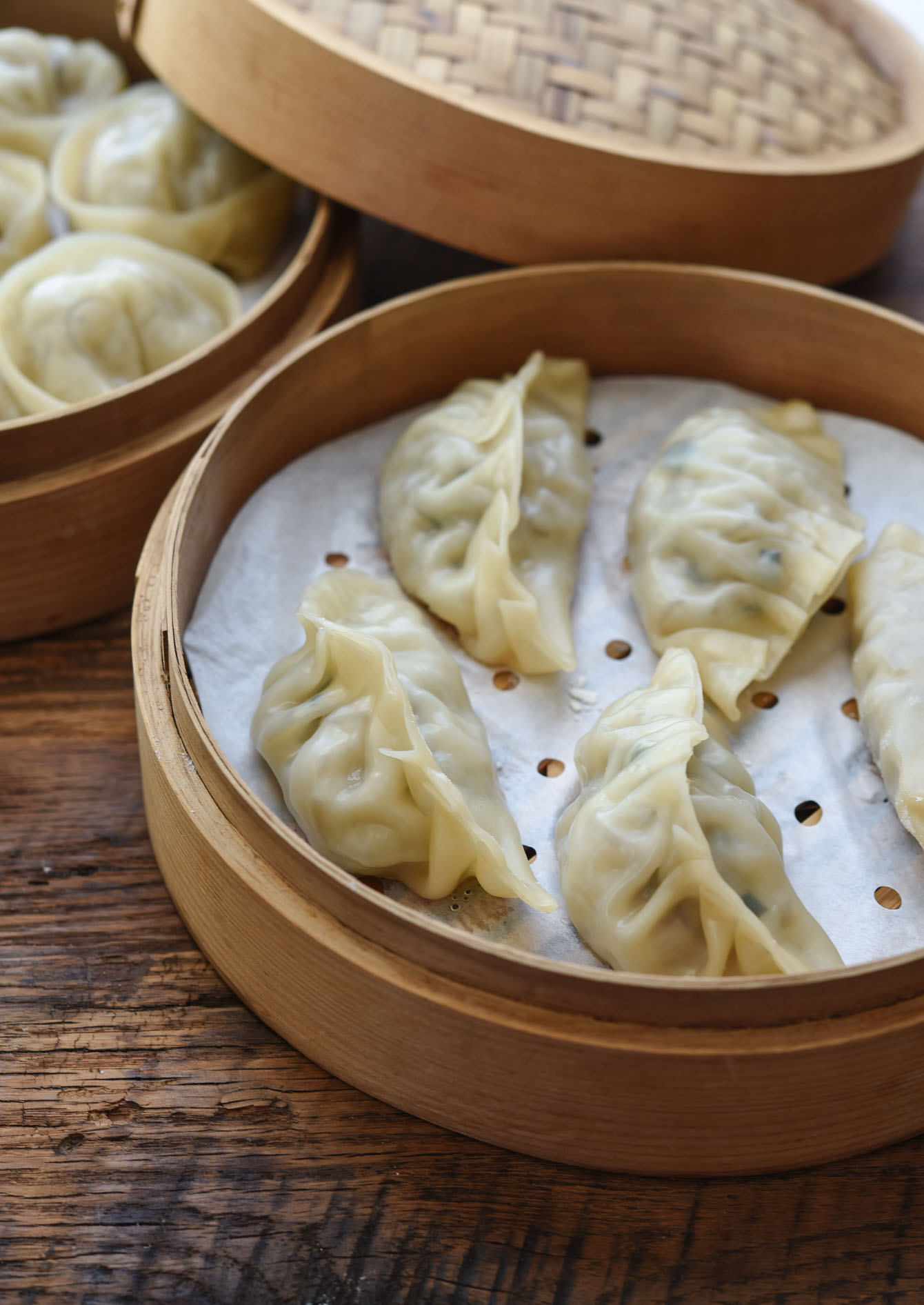
What is Mandu?
Mandu, or Korean dumplings, are a popular dish made by wrapping a thin dumpling dough around a savory mandu filling known as “mandu-so (만두소)”, and folded in different patterns. This filling usually includes ground meat, tofu, vegetables, and seasonings like garlic and green onions.
The process of making dumplings is simple and enjoyable, perfect for a family or any group activity. Once filled and sealed, mandu can be cooked in several ways—steamed, boiled, or fried to golden perfection.
These versatile Korean dumplings serve as a delicious appetizer or a part of a hearty meal, such as Korean dumpling soup (mandu-guk, 만두국) for the New Year celebration, or dumpling hotpot, offering a delightful sample of traditional Korean flavors.
Korean Lunar Year Tradition
My childhood memories of Lunar New Year are filled with helping my mother preparing Tteokguk (Korean rice cake soup) – the must have Lunar New Year food, along with Galbi-jjim (Korean braised ribs) or Bulgogi, Japchae, and etc . These Korean pork dumplings are one of them. I recall that she tried a different filling every year.
Creating homemade Korean mandu is a joyful family activity during the festive holiday. Being the heir, my father’s siblings, uncles, aunts, and cousins gathered at our house to celebrate.
Picture family members around the table, hands busy crafting tasty dumplings together, celebrating the new year’s beginning. These dumplings symbolize blessings for you and your loved ones.
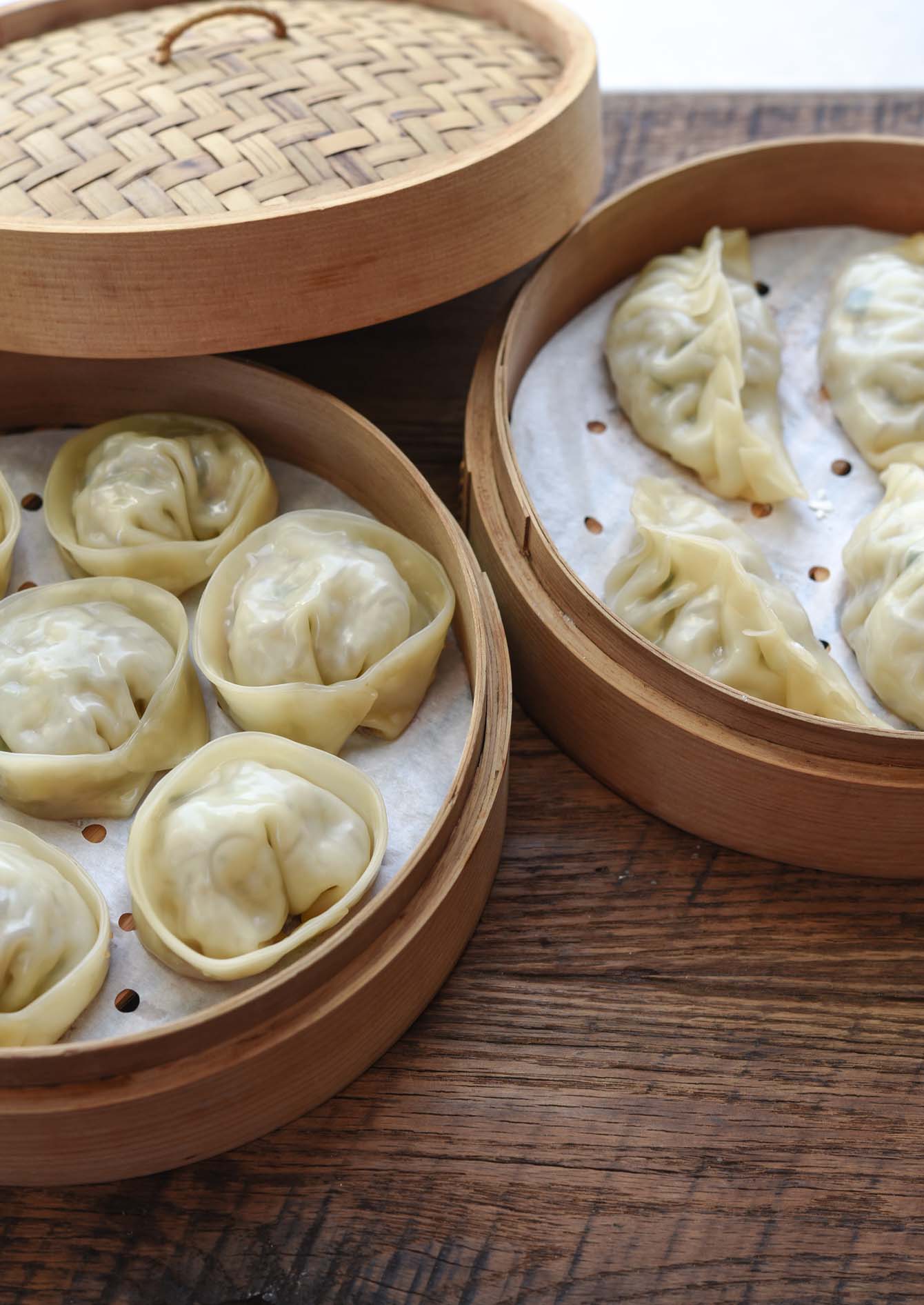
Mandu vs. Dumplings, Potstickers, and Gyoza
“Dumpling” is an umbrella term for stuffed dough creations found worldwide, including varieties like potstickers, gyoza, and mandu. Potstickers, a Chinese favorite, are crispy on the bottom and chewy on top, while gyoza, their Japanese relatives, are known for their thin wrappers and subtle seasoning.
Mandu, on the other hand, is the Korean take on dumplings, with a distinctive mix of local flavors and ingredients. Each type reflects its cultural roots through specific fillings, seasonings, and cooking methods, with mandu being Korea’s unique contribution to the global family of dumplings.
Mandu Variation
When it comes to the variety of mandu, Korean dumplings offer flavors for every taste. Gogi mandu is a meat-lover’s delight, typically filled with juicy beef or pork with savory vegetables.
Yachae mandu is a vegetarian’s dream, packed with fresh vegetables like mushrooms, tofu, and glass noodles, making it both flavorful and filling. Saewu mandu brings a taste of the sea with its shrimp filling, often mixed with green onions and ginger for that extra zing.
Then there’s the zesty kimchi mandu, where the star ingredient is kimchi, often combined with tofu to create a dumpling that’s both spicy and soft.
Korean Dumpling Made from Scratch
Making homemade mandu dumplings has two components; dumpling wrappers and dumpling filling.
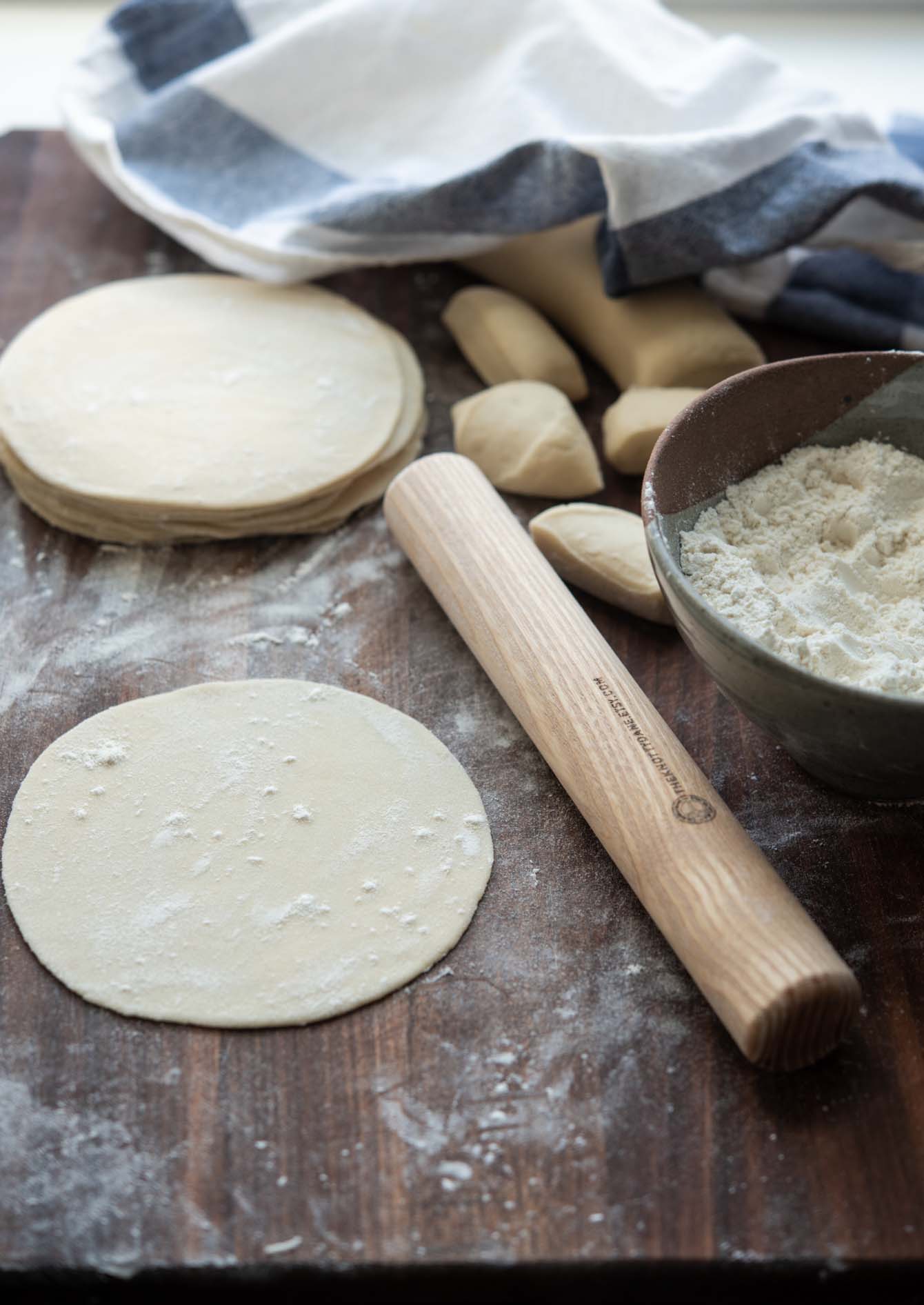
Dumpling wrappers (mandu-pi, 만두피)
Don’t be afraid to make homemade dumpling wrappers from scratch. My recipe blends flour, sweet rice flour, and cornstarch for that special tender and chewy texture. If you’re short on time, store-bought wrappers can work too—just choose the larger size (about 5 inches in diameter) for a true Korean-style mandu.
Dumpling filling (Mandu-so,만두소)
Traditional Korean mandu features minced pork with a juicy taste that pairs well with veggies like kimchi and tofu. For the best filling, use ground pork with some fat—about an 80/20 mix—to keep your dumplings moist and flavorful, avoiding the dryness that comes with leaner meat.
Ingredients for Dumpling Filling
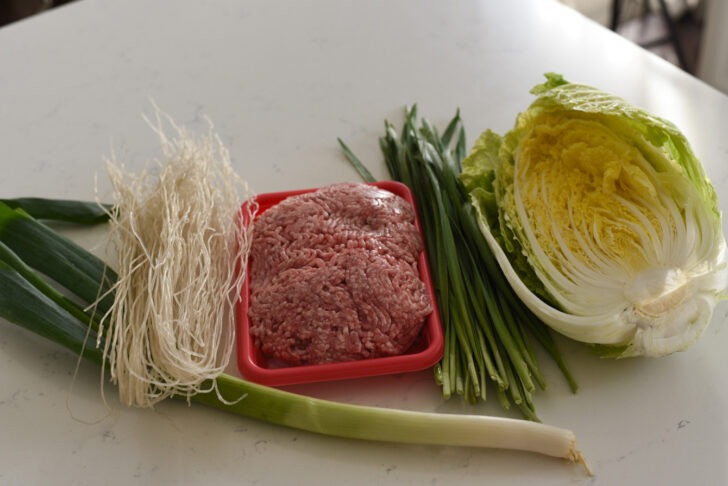
- Ground Pork: The foundation of mandu filling. Opt for an 80/20 meat-to-fat ratio for a juicier texture.
- Nappa Cabbage: Adds a sweet, slightly peppery crunch to the mix.
- Asian Chives: Bring a mild onion-like flavor, enhancing the overall taste.
- Asian Leek or Green Onion: Offers a depth of flavor with its sharp, earthy notes.
- Korean Glass Noodles (Dangmyun): Contribute a pleasant chewy texture to the filling, unique to Korean cuisine.
- Check out my easy japchae recipe for another idea of using Korean glass noodles.
How to make Mandu (Korean dumpling)
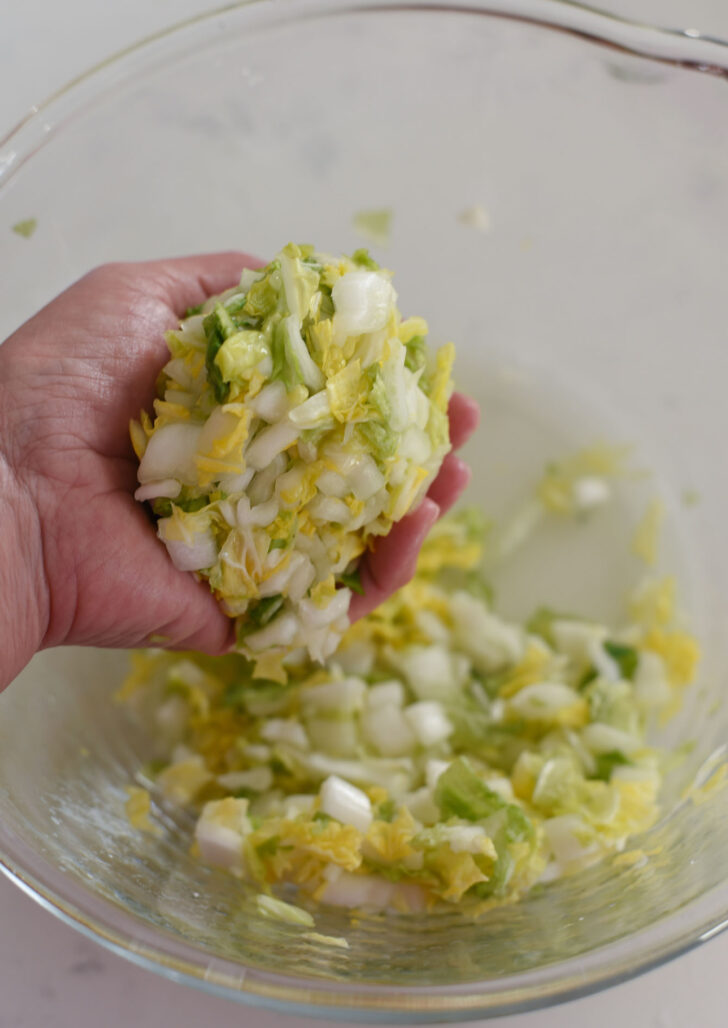
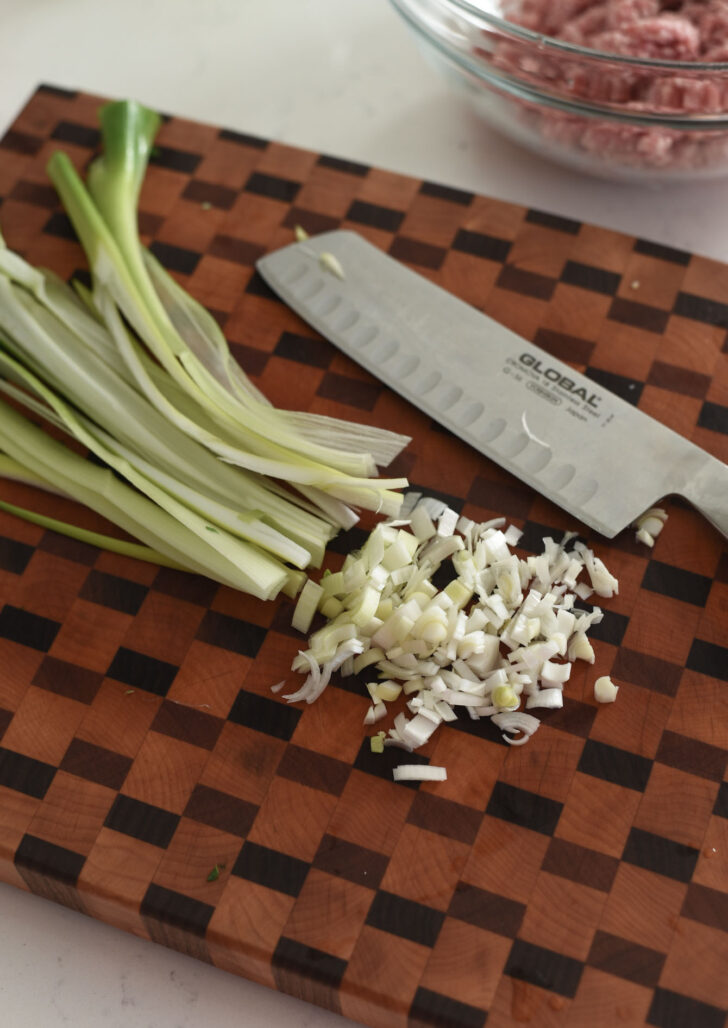
Preparing Cabbage and Herbs for Mandu Filling:
- Sprinkle a teaspoon of salt over the chopped cabbage and leave it to soak for 10 minutes. Once the cabbage has wilted, give it a good squeeze to remove excess moisture.
- For the chives and leeks, chop them finely. Should Asian chives be unavailable, simply use a larger quantity of green onions as a substitute.
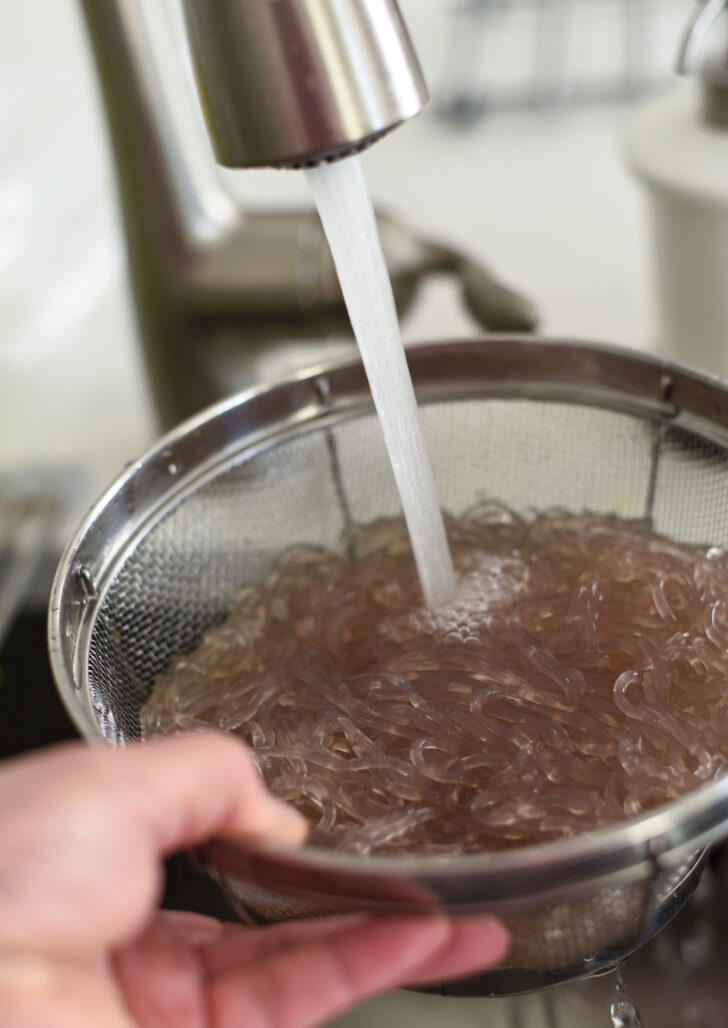
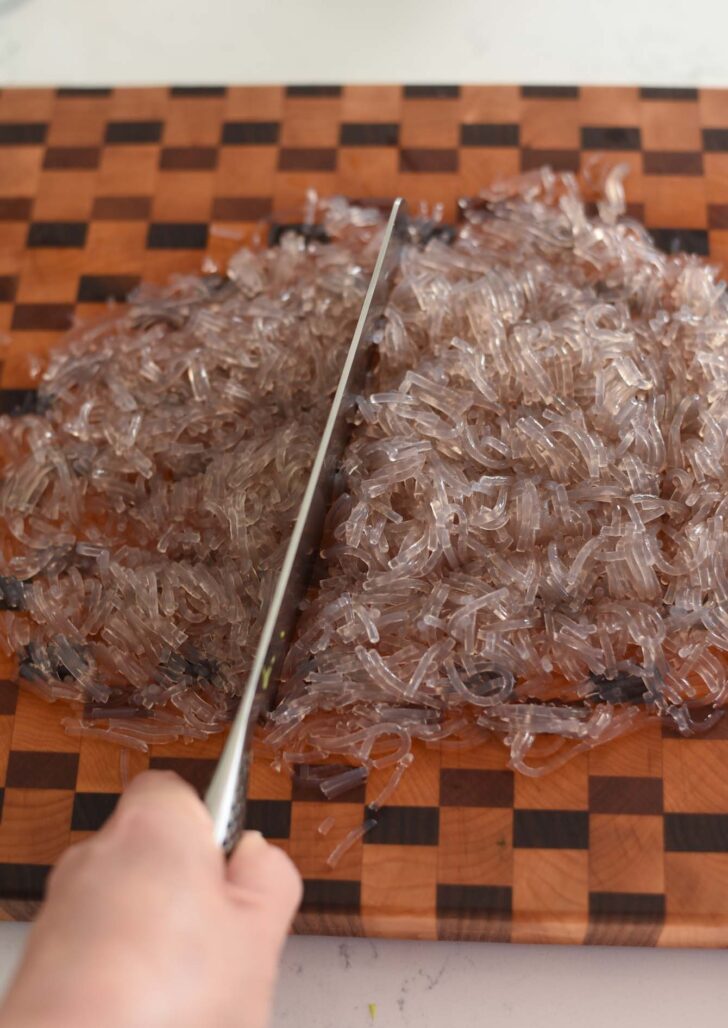
Cooking Korean Glass Noodles (Dangmyeon):
- Cook the Korean glass noodles as instructed on the package, typically for 6-7 minutes. After boiling, rinse them under cold water and ensure they’re well-drained.
- Then, chop the noodles into small, bite-sized pieces.
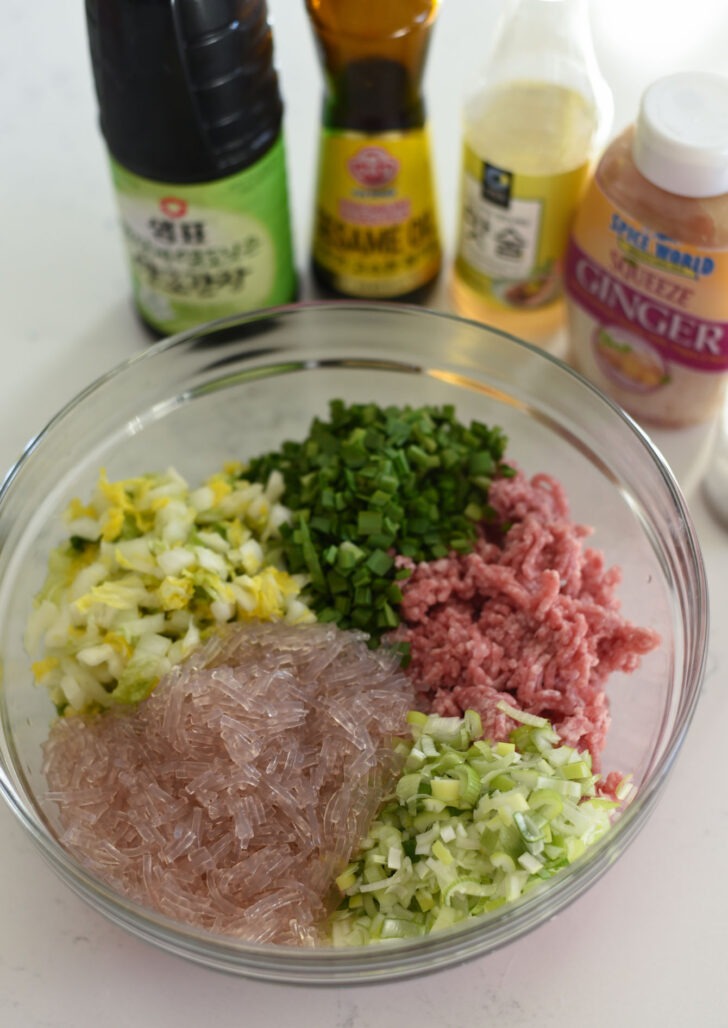
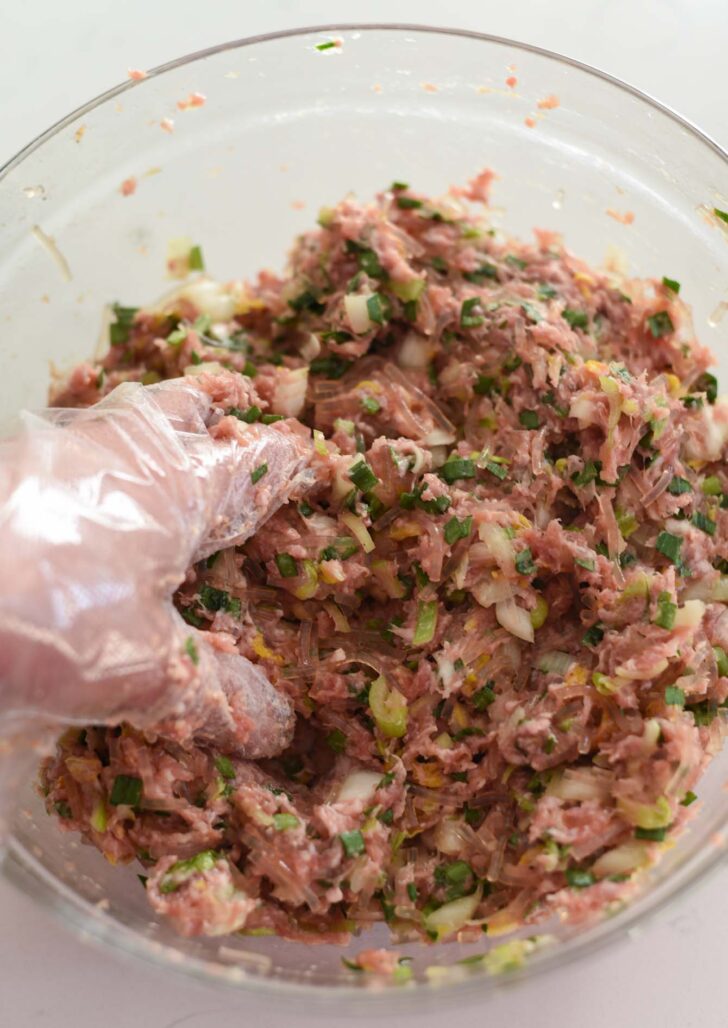
Mixing Mandu Ingredients:
- Combine pork, cabbage, chives, leek, and noodles in a large bowl. Add soy sauce, sweet rice wine, ginger, sesame oil, and pepper to the mix.
- Use your hands to blend everything thoroughly until the ingredients are fully integrated.
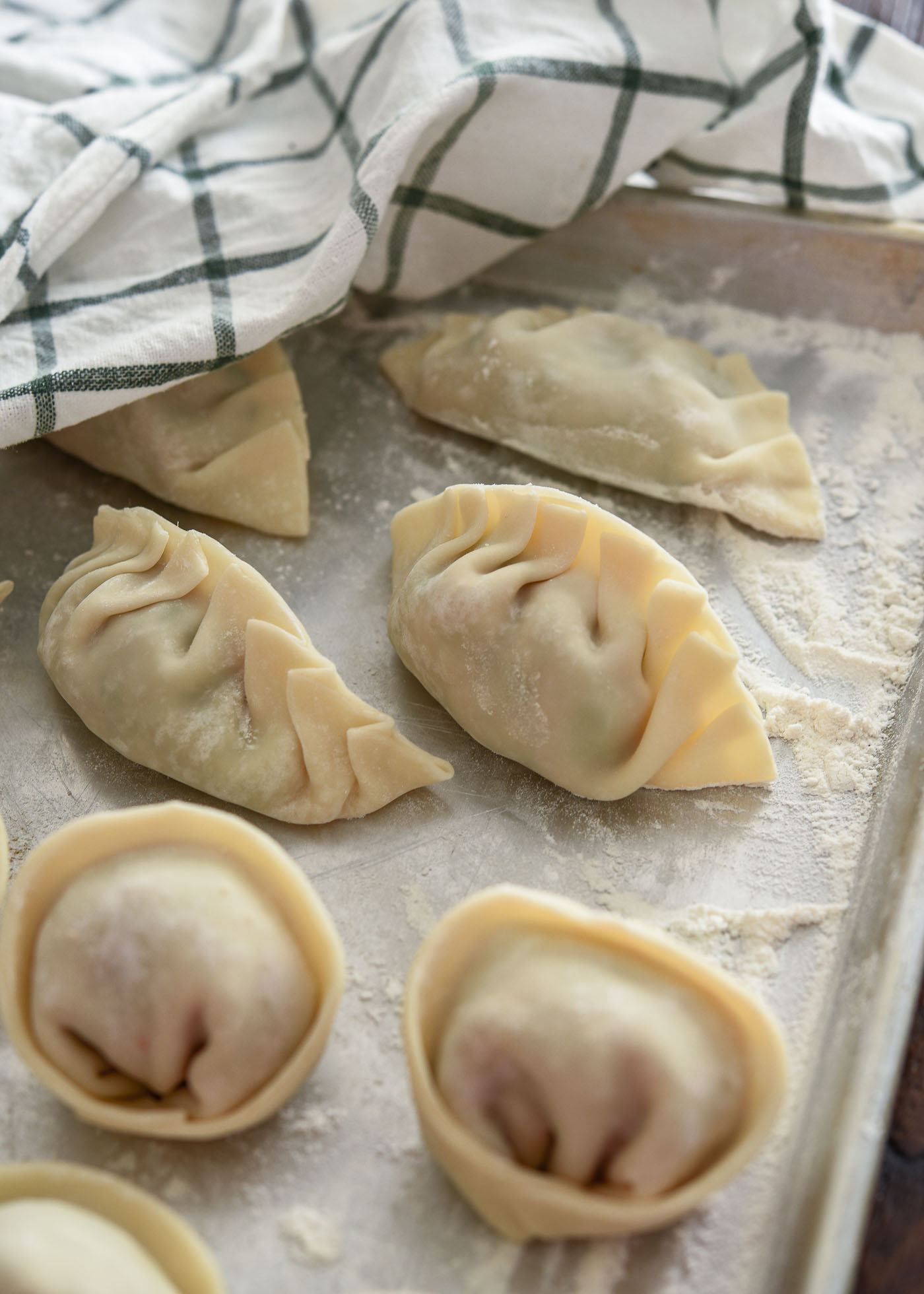
How to fold mandu
My mother used to say if you can fold a pretty dumplings, you will have a good looking son. If you can make Korean sweet rice cakes (Songpyeon) into a perfect shape, you will have a pretty daughter.
I think she was right! I do have a good looking son and a pretty daughter.
There are so many different shapes and patterns of folding dumplings. Here are the two of the most popular and easy.
Moon shape
Moon shaped round dumplings are the most common in Korean dumplings. This shape is perfect for steaming and making soup.
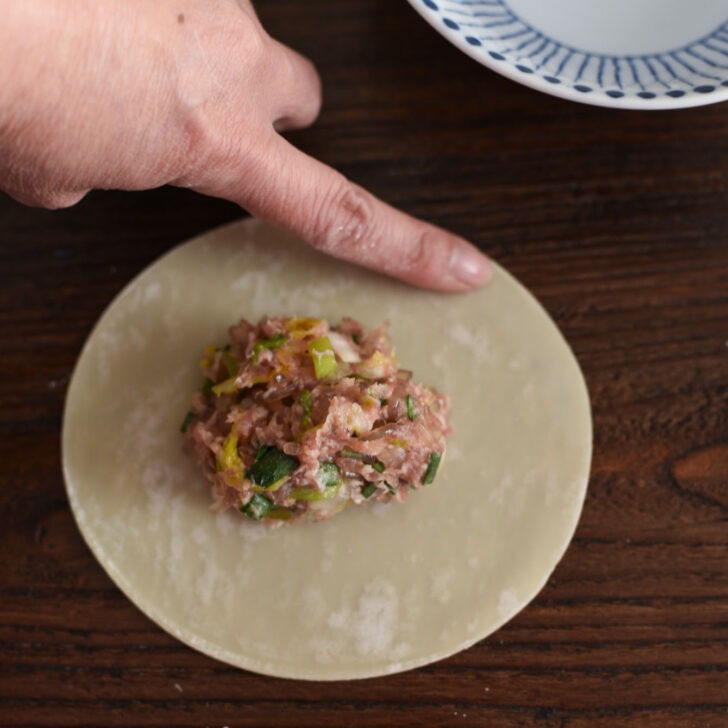
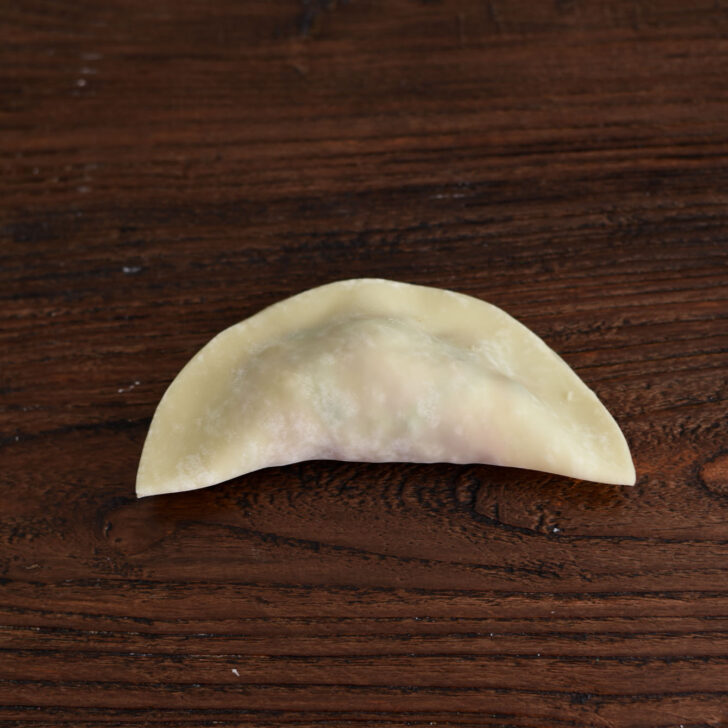
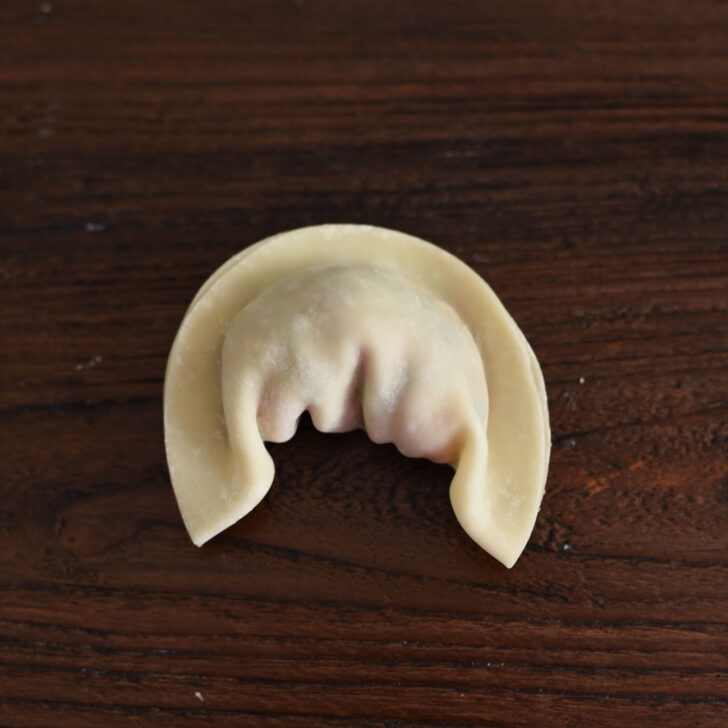
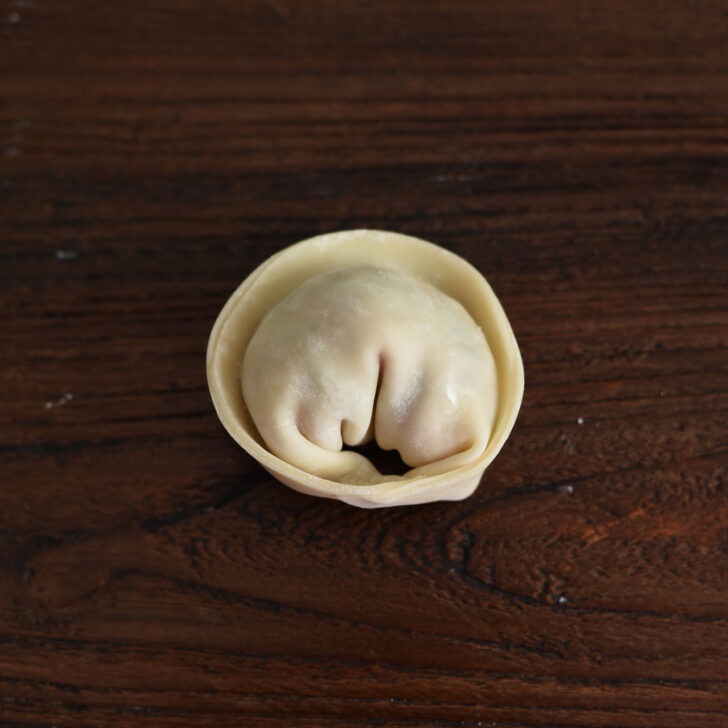
- Put a heaping tablespoon of filling in the middle of wrapper, wet the edges of wrapper with water using your finger.
- Fold the wrapper in half and pinch the edges together.
- Bring the both ends toward the center.
- Pinch the ends together to complete.
Pleated shape
Pleated shape is a great option for both steamed and pan fried dumplings. If you have never folded dumplings before, try with a small amount of filling inside first.
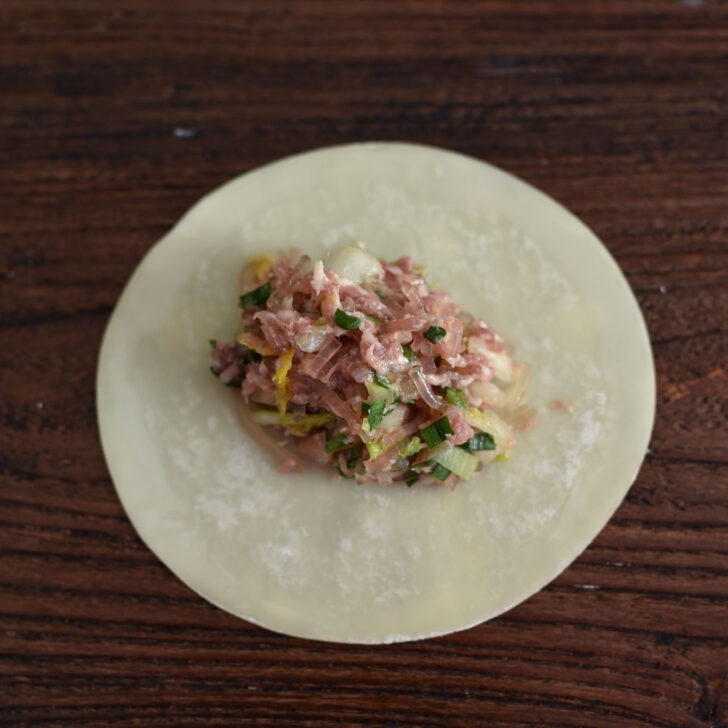
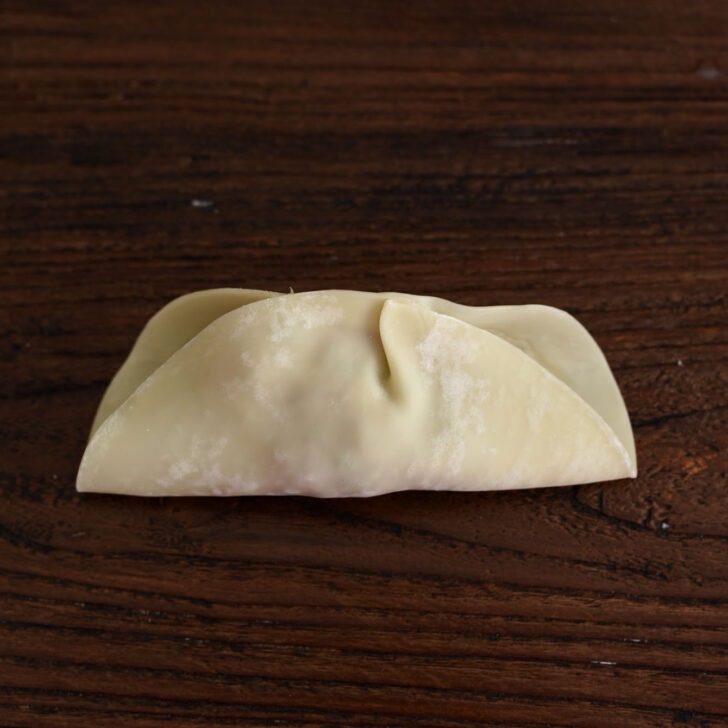
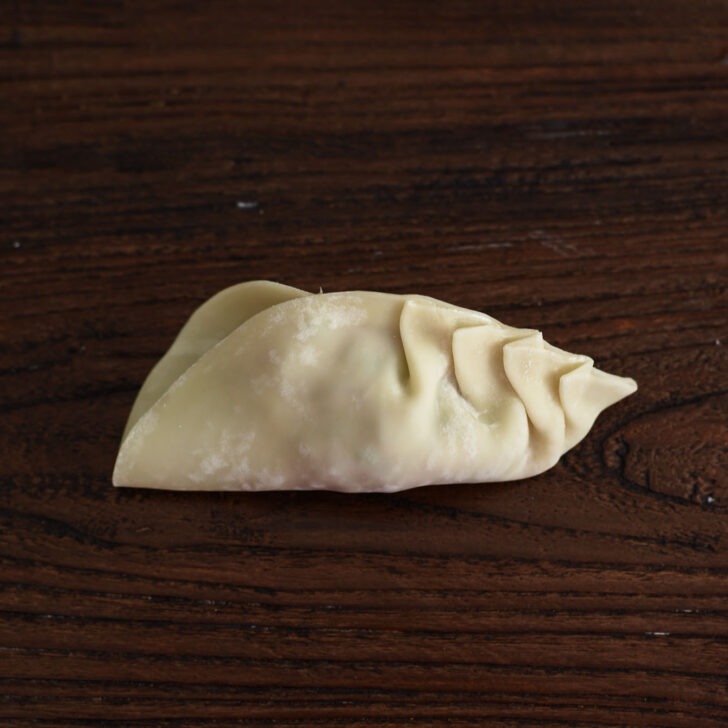
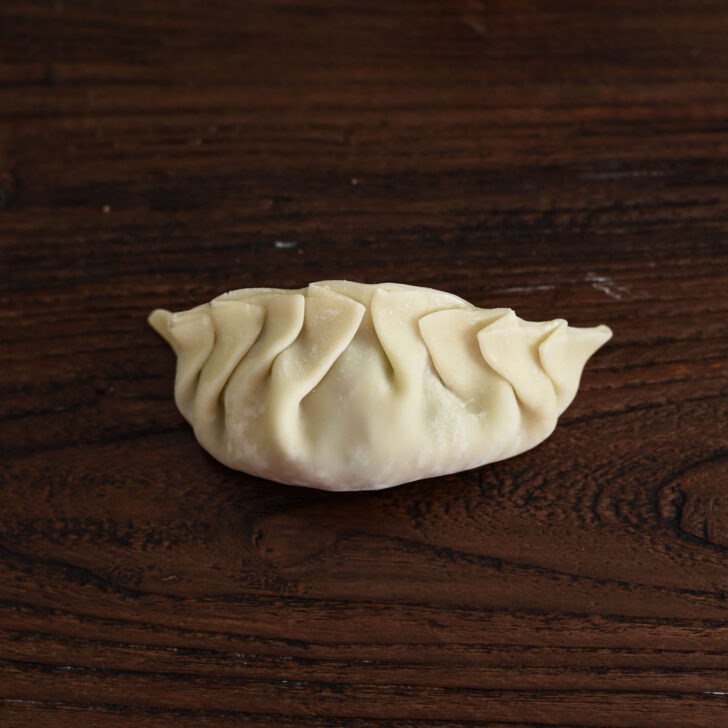
- Put some filling in the middle of the wrapper and wet the edges with water using your finger.
- Bring one edge to the other and pinch in the center first, then make a small pleat on one side facing toward the center .
- Continue to make more pleats, usually about 4 pleats.
- Create the same number of pleats on the other side, facing the pleats toward the center.
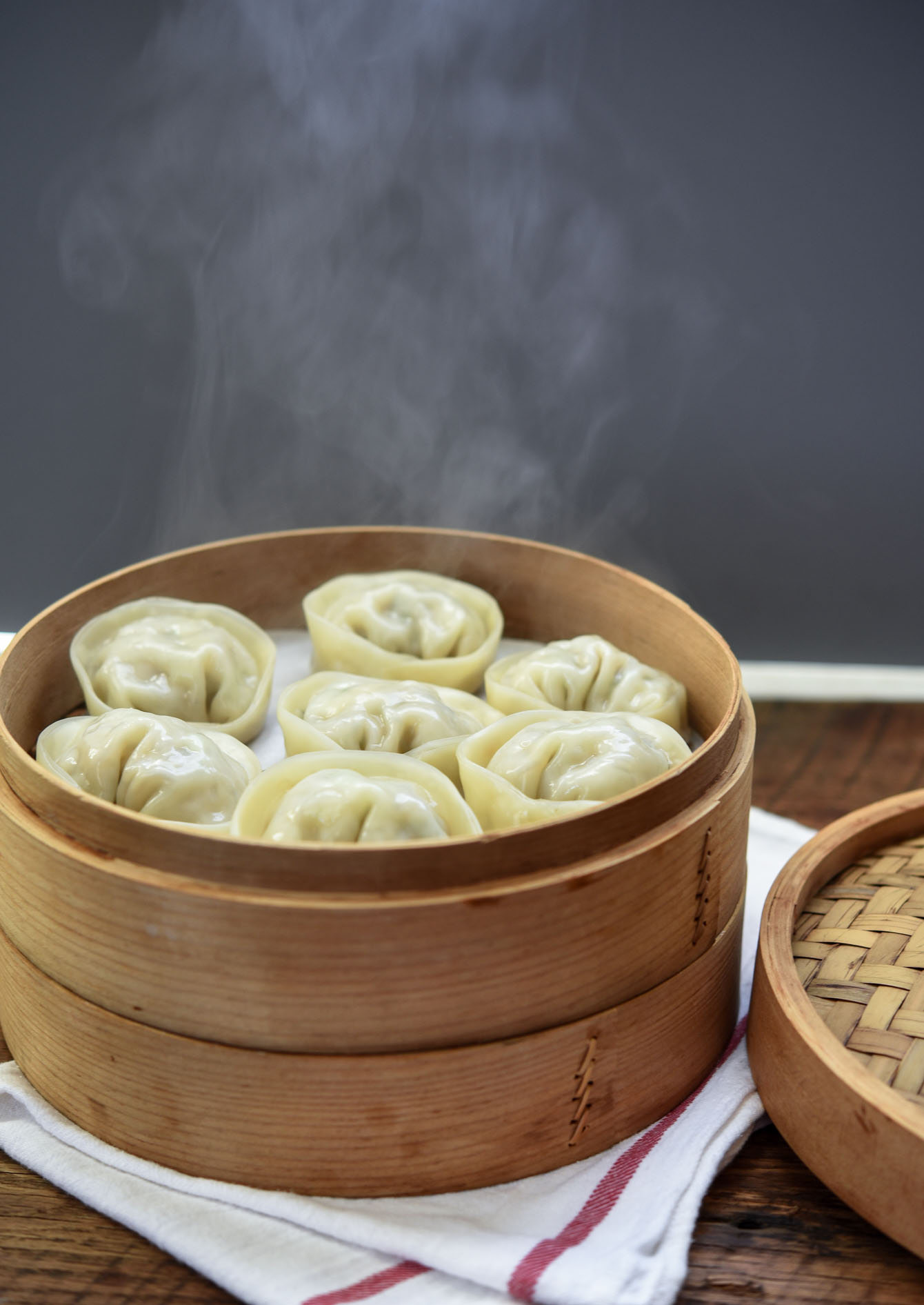
Cooking Methods for Mandu
Mandu can be cooked in a variety of ways, each method bringing out different textures and flavors.
- Steamed Mandu (jjin-mandu, 찐만두): Steaming preserves their delicate flavor and soft texture, making it a healthy cooking choice. This method steams the dumplings evenly, ensuring they come out perfectly tender without being waterlogged.
- To steam, set a bamboo steamer or other steamer over simmering water. It’s important to line the steamer with a steam liner or kitchen cloth to prevent sticking.
- Pan-Fried Mandu (Gun-mandu, 군만두): Pan-frying transforms mandu into a textural delight with a crispy exterior and chewy interior.
- Heat oil in a pan, place the dumplings flat-side down, and cook until the bottom turns golden brown.
- A splash of water and a quick cover with a lid will steam the tops, giving you the perfect crispy-chewy combination.
- Deep-Fried Mandu (Tuigim-mandu, 튀김만두): Deep-frying gives mandu a golden crunch that’s hard to resist. Submerge the dumplings in hot oil and fry until they are uniformly golden and crispy.
- This method is ideal for those who crave a richer flavor and a crunchy bite.
- Boiled Mandu (Mul-mandu, 물만두): This is the simplest method, yielding soft, versatile dumplings that are comforting to bite into.
- Drop the mandu into a pot of boiling water and cook until they float to the surface, indicating they’re ready to be enjoyed in your favorite soup or with a dipping sauce on the side.
Mandu dipping Sauce
Korean dumpling dipping sauce is a mixture of 2 parts soy sauce, 1 part vinegar, and 1-2 teaspoons of Korean chili flakes (gochugaru) for a little spice. This simple sauce is salty, tangy, and has a hint of heat. It’s just right for dipping your hot, juicy mandu.
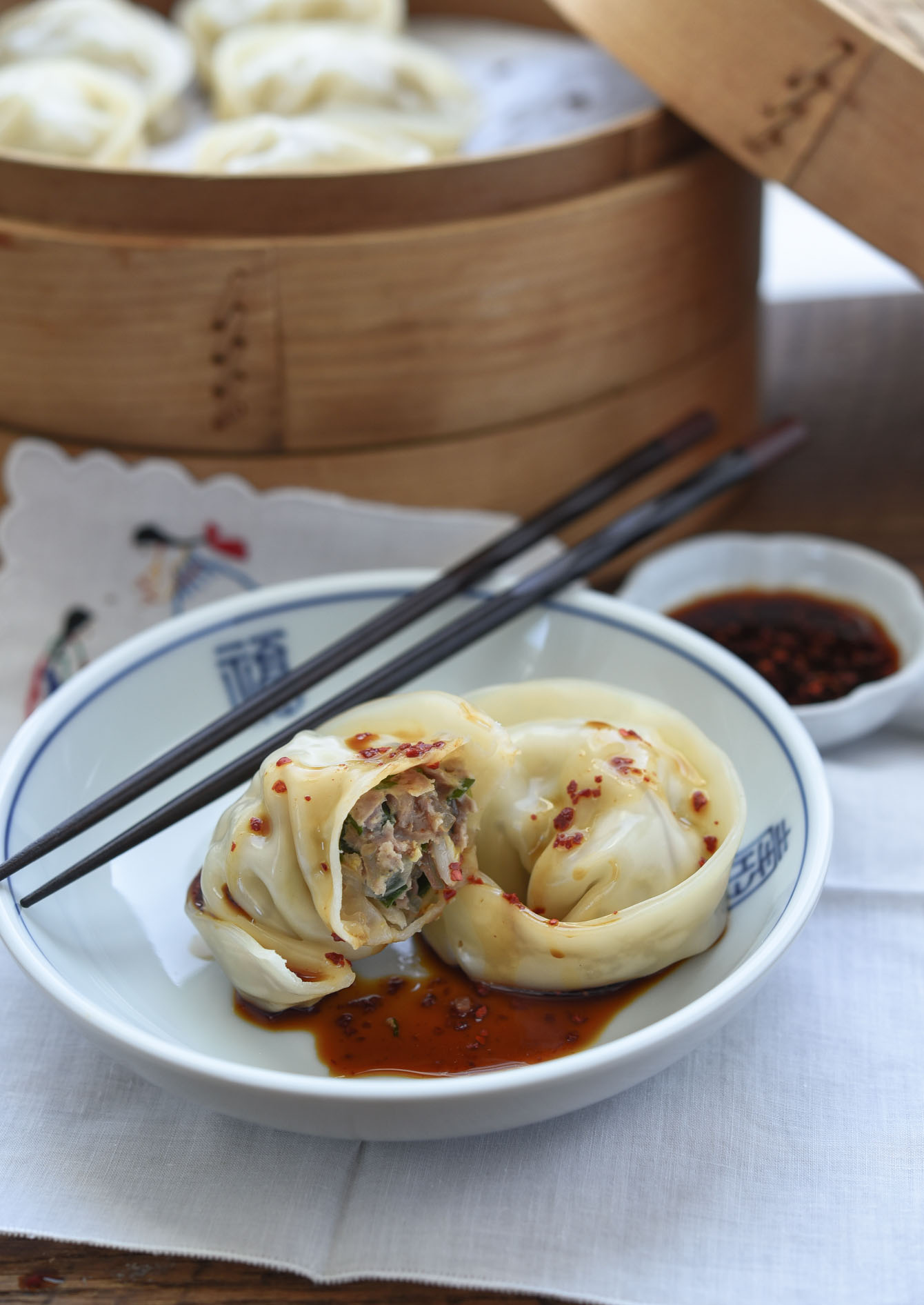
Freezing Tips
It is always a good idea to make abundant homemade dumplings because they freeze beautifully. Make sure to sprinkle flour on a large tray so that they won’t stick to the tray.
Place dumpling pieces on the floured tray without touching each other. Put them in the freezer for an hour or until they freeze solid. Transfer the individual pieces to freezer bags. They can last up to 3 months in the freezer.
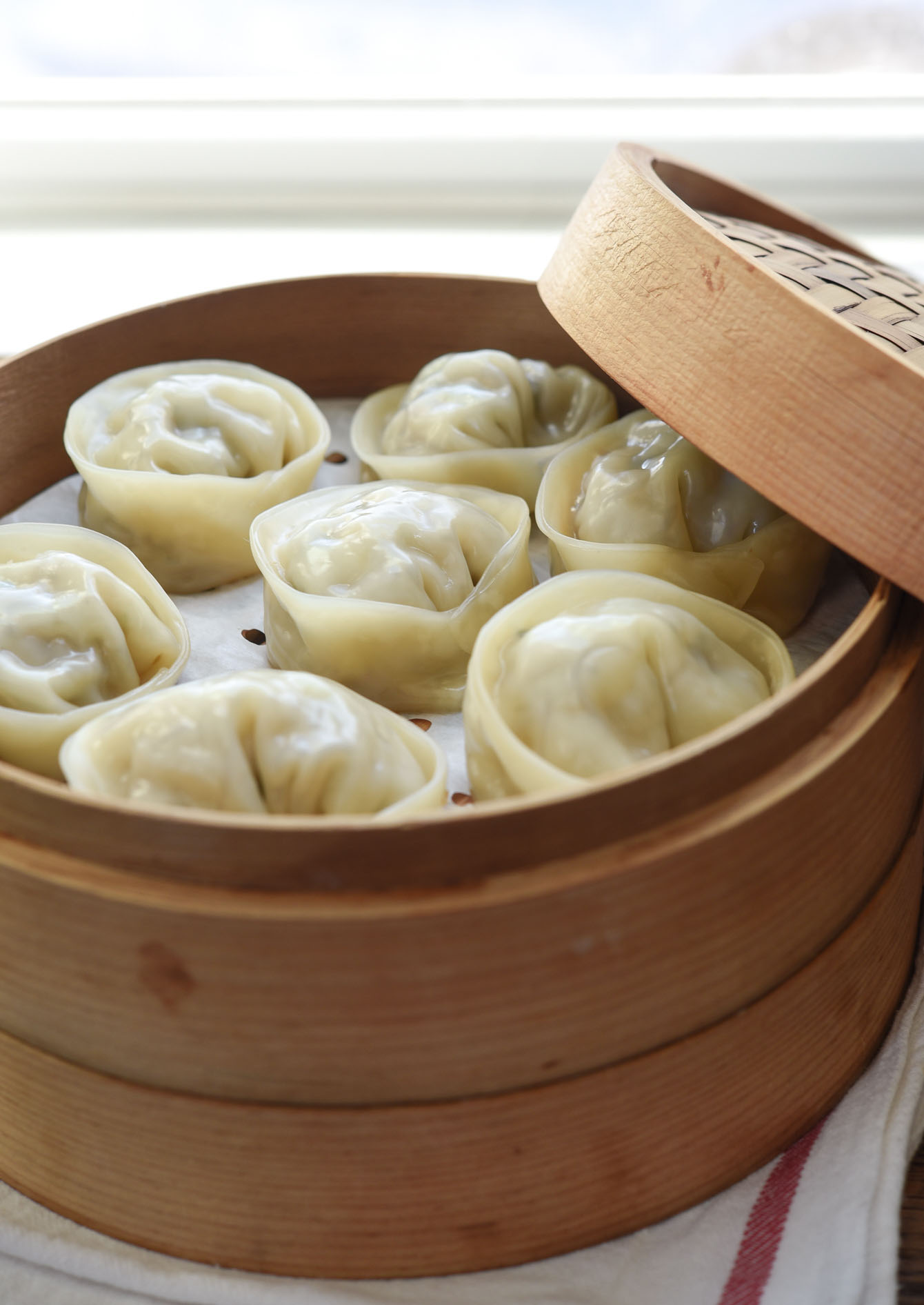
More Authentic Korean Recipes
If you are a Korean food enthusiast, here are a few of authentic Korean recipes that you can easily make at home.
- Bibimbap (Easy Recipe)
- Beef Bulgogi Recipe (Korean BBQ Beef)
- Tteokbokki (Spicy Korean Rice Cake)
- Korean Fried Chicken
- Galbitang (Beef Rib Soup)
- Easy Kimchi Recipe
Love this recipe? Rate it and share your experience in the comments below! On Instagram? Tag me to showcase your creation. For more delicious recipes, subscribe to our newsletter!
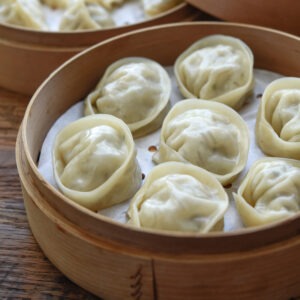
Homemade Mandu (Korean Dumplings)
Ingredients
- 40 Korean dumpling wrappers, about 5-inch (13 cm) diameter
For mandu filling
- 7 oz (200 g) napa cabbage
- 1 tsp salt
- 3 oz (85 g) Korean glass noodles (dangmyeon)
- 1 1/2 lb (680 g) minced pork
- 1 cup (25 g) finely chopped Asian chives
- 1 cup (80 g) finely chopped Asian leeks or green onion
- 2 tbsp soy sauce
- 2 tbsp sweet rice wine (mirim)
- 1 tsp ginger paste
- 1 tbsp sesame oil
- 3/4 tsp black pepper
For dipping sauce
- 4 tbsp soy sauce
- 2 tbsp rice vinegar
- 2 tsp Korean chili flakes (gochugaru), optional
Equipment
Instructions
To make the mandu filling
- Chop napa cabbage very finely and put it in a mixing bowl. Sprinkle 1 tsp salt and toss together; let it sit for 10 minutes. When the cabbage becomes lifeless, squeeze it out to get rid of moisture.
- Boil Korean sweet potato noodles according to the package directions, about 6-7 minutes. Rinse in cold water and drain well. Chop into small pieces.
- Put pork, cabbage, chives, leeks, and noodles in a large mixing bowl. Season with soy sauce, sweet rice wine, ginger, sesame oil, and pepper; mix well with your hand until all the ingredients are well incorporated.
To shape half moon dumplings
- Put a heaping tablespoon of filling in the middle of wrapper, wet the edges of wrapper with water using your finger. Fold the wrapper in half and pinch the edges together. Bring the both ends toward the center. Pinch the ends together to complete.
To shape pleated dumplings
- Put some filling in the middle of the wrapper and wet the edges with water using your finger. Bring one edge to the other and pinch in the center first, then make a small pleat on one side facing toward the center. Continue to make more pleats, usually about 4 pleats. Create the same number of pleats on the other side, facing the pleats toward the center.
To steam the mandu (dumplings)
- Bring a small amount of water in a large pot to boil. Make sure the bottom of your steamer doesn't touch the water. Place mandu without touching each other in a bamboo steamer (or regular steamer), lined with a cheese cloth or a steam liner. When the water boils, place the steamer over or in the pot. Cover and steam for 5 minutes. Serve immediately.
- Meanwhile, make dipping sauce to go with dumplings. Combine all the sauce ingredients and drizzle it over dumplings.

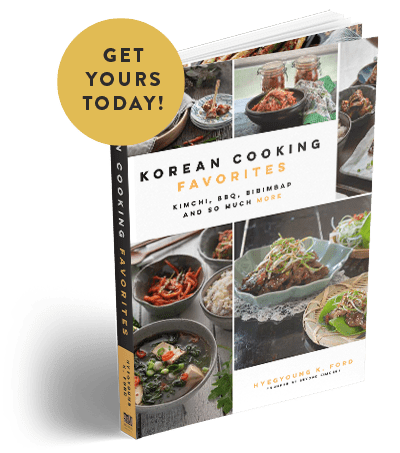
Looks yummy… will try it… I myself is a dumpling wrapper, now my daughter… would love to try and make it for her. 🙏
Making this for my Korean best friend this weekend for his birthday, one question though. When you say freeze is that before or after the steaming? Is it possible to fill and shape the dumplings, refrigerate overnight and stream the next morning?
You can freeze the dumplings before steaming. Make sure that dumplings won’t touch each other to prevent from sticking. You can also shape the dumplings and store in the refrigerator and steam next day. Thanks.
감사합니다 – (gam-sa-ham-ni-da) Holly!
Out to buy ground pork, though 1.5 lbs is not sold here…..ground meats are packaged at 1lb. Will just adjust the recipe accordingly!
Hi Philip
You can use 1 lb of ground pork and adjust the recipe accordingly. Or get 2 packages and use 1.5 lb, and save the rest for another use, which I often do. Thanks!
I will be trying this recipe this week. Thanks for your hard work.
I just happened to travel to the nearest Asian market and picked up glutinous rice flour – not even knowing it is what is used for mandu….I use rice flour in bread baking to handle the wet dough.
One question. I am growing Chinese garlic chives. Are these the chives mentioned in this recipe? I find them so dry and hard….I would think they would need to be blanched before using in the dumpling….or perhaps cut small enough it won’t matter?
Thanks again!
Hi Philip
Yes, Buchu is Chinese garlic chives I used in the recipe. You will need to chop them very small, about 1/2 inch in length. Raw garlic chives are dry and hard as you mentioned, but once cooked, they become soft and pliable, and very aromatic. Hope this helps and good luck with making Korean dumplings!
I lost my Korean Mother a little over a year ago. She tried to teach me her methods for mandu and I think I got most of it down. But, your pictures and directions on how to form the mandu are excellent and I need to practice more! She never suggested sweet potato noodles in ours – but we always had chop chae (sp??) with those noodles. I am so glad I found your blog – even at the ripe old age of 66! I see I have lots to learn still and then I can pass the methods and recipes down to my daughter. Thank you for sharing everything in Korean cooking!
I just made these today and my family LOVES them. I had to use dried chives instead of fresh Asian chives, and grape juice instead of sweet rice wine but it still tasted amazing to us. My great-aunt said that they tasted as good as restaurant dumplings. I’ve never had dumplings before this, now I’ll be comparing every other kind of dumplings I try to your Mandu. The half-moon shaping was by far the easier method to me. Thank you so much! And I can’t wait to try more of your recipes.
Hi Emma
I am so glad to hear that you tried my recipe and loved it. Yes, half moon shape is the easiest one to make. Hope you get to try other recipes from my site soon. Let me know if you have any question regarding my recipes. Thanks for the comment.
Is there any replacement for Asian chives as there not available where I’m from??
Hi Kacie
You can use finely chopped green onion instead of chives. Thanks.
Hello! I’m making these today, and only have rice vermicelli, will that be ok, or should I just omit the noodles?
Thank you!
Hi Michelle
You can just omit the noodles. Rice vermicelli is different than glass noodles and it gets soggy quickly.
what is ginger puree?
Ginger puree is a store-bought pureed ginger, usually sold in a tube or jar. You can replace it with grated fresh ginger (but use a slightly less amount than specified).
Thanks for the recipe. The Mandu were perfect and so much fun to make!
I have a question. Recently I saw the Korean series Chocolate and had great fun watching the food prep and the variety they ate. There was one dish that translated as Dumpling stew. It looked like Mandu in a broth. Any thoughts of what kind of broth that could be? And some of the Mandu were ENORMOUS,,
Hi Marian
I’m so glad to hear the my mandu recipe turned out perfect for you. It surely is fun to make, isn’t it?
To answer your question..
Yes, there is a dish called mandu guk (dumpling soup). It is easy to make if you have dumpling already made. All you need to to make soup stock to simmer the dumplings in. The typical stock we use for dumpling soup in Korea is the anchovy stock. Check my Korean soup stocks for more information.
You can also use chicken or beef stock as the dumpling soup stock as well if anchovy is not your thing. Kimchi on the side is a must when you serve Korean dumpling soup. Hope this helps.
I have been looking for dumplings, this recipe is amazing
Haha – I love your mother’s comments about having a good looking son and daughter! Based on these dumplings, I think it’s safe to say you do indeed have a good looking son and daughter. These look amazing! I’ve never made dumplings at home from scratch, but the pandemic seems to be a good excuse to tackle a project like this. My mouth is watering just thinking about these!
Thanks David for your nice comment. I do, indeed, have beautiful son and daughter. Making homemade dumplings every New Year wishing for beautiful kids did seem to work!
Hope you get to try. It’s time consuming, but therapeutic and relaxing work to do with loved ones. You will be rewarded.
Hello, I made your dumpling wrapper and filling for Valentine’s day and Lunar new year. So good. I don’t know why I was intimidated in making dumplings. My daughter and I made them together. It took a bit of time getting used to rolling out the wrappers. I finally got it circular towards the end. The filling is very good and juicy. My daughter, a teen, said it was good and that’s huge. I’m excited to make more and freeze. Thank you!!
That’s so neat to hear you and your daughter loved my dumpling recipe. How sweet it is to make dumplings together as a family! I know making dumplings from scratch can be intimidating at first. But I think, with a little practice, anyone can make beautiful dumplings. Glad that you are making more. Enjoy!
Quick update, my husband and son came back later in the day. Son, gobbled them up. Loved the filling. And husband kissed me and told me to make more. Followed your recipe exactly.Thanks again. Sending you a big hug!
Happy Lunar New Year Holly! What a fabulous post with great tips and step by steps for making Korean dumplings. Photos are just gorgeous too. Wishing you a super weekend ahead.
Thank you. Wishing you a happy healthy New Year to you as well.
I love all types of dumplings and these mandu are are no exception! They look delicious! Love the pleating instructions too. Thanks for stopping by my site, Holly! Glad to meet you here 🙂
Thank you Michelle. Dumplings of all kind are the best thing in the world!
I love dumplings of every sort. These sound great. My son is home from Taiwan and we plan on making a bunch this weekend!
I used to live in Taiwan, about 25 years ago, and I miss that place a lot. Good food!
I am sure it is so nice to have your son coming home from far away. Hope you have a good time with him making dumplings. How fun!!
They look very yummy and just remind me that I haven’t made or had dumplings in a while. Wish I could taste some of yours now 🙂
I wish I can share with you, too. Hope you get to try some dumplings soon.
Love, love, LOVE dumplings! Any and all. 🙂 These look so terrific — thanks.
I can eat any dumplings all the time, too.
Fabulous! I used egg roll wrappers and they were fine. Also couldn’t find sweet potato noodles, so used ramen. Only problem, they take hours to prepare and seconds to eat!